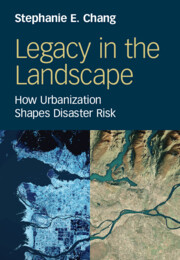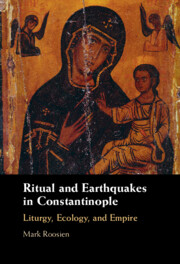Refine search
Actions for selected content:
186 results

Legacy in the Landscape
- How Urbanization Shapes Disaster Risk
-
- Published online:
- 11 November 2025
- Print publication:
- 11 September 2025
6 - Tectonics and Mountain Building
-
-
- Book:
- Essentials of Geomorphology
- Published online:
- 12 November 2025
- Print publication:
- 23 October 2025, pp 97-119
-
- Chapter
- Export citation
1 - Complexity
-
- Book:
- Gateway to the Mediterranean
- Published online:
- 04 December 2025
- Print publication:
- 16 October 2025, pp 17-35
-
- Chapter
- Export citation
3 - Coping with Disaster
-
- Book:
- The Nature of the Ottoman City
- Published online:
- 28 August 2025
- Print publication:
- 11 September 2025, pp 115-166
-
- Chapter
- Export citation
1 - Introduction
-
- Book:
- Satellite Radar Interferometry
- Published online:
- 13 September 2025
- Print publication:
- 04 September 2025, pp 1-7
-
- Chapter
-
- You have access
- Open access
- Export citation
Container City Experiences of Nurses Providing Voluntary Health Care Services Following the Earthquake: A Qualitative Approach
-
- Journal:
- Disaster Medicine and Public Health Preparedness / Volume 19 / 2025
- Published online by Cambridge University Press:
- 07 August 2025, e225
-
- Article
- Export citation
Addressing Nutrition Service Management After the 2023 Kahramanmaraş Earthquakes
-
- Journal:
- Disaster Medicine and Public Health Preparedness / Volume 19 / 2025
- Published online by Cambridge University Press:
- 07 August 2025, e220
-
- Article
- Export citation
The Experiences of Nurses Who Participated in Disaster Relief Efforts After the February 6, 2023 Earthquakes in Türkiye: A Qualitative Study
-
- Journal:
- Disaster Medicine and Public Health Preparedness / Volume 19 / 2025
- Published online by Cambridge University Press:
- 29 July 2025, e210
-
- Article
- Export citation
Geospatial Analysis for Identifying Socially Vulnerable Areas to Natural Disasters
-
- Journal:
- Disaster Medicine and Public Health Preparedness / Volume 19 / 2025
- Published online by Cambridge University Press:
- 25 July 2025, e208
-
- Article
- Export citation
Earthquake Survival Strategies: Potential Advantages of the Fetal Position in the Triangle of Life to Survive Over the “Drop, Cover, and Hold On”
-
- Journal:
- Disaster Medicine and Public Health Preparedness / Volume 19 / 2025
- Published online by Cambridge University Press:
- 07 July 2025, e181
-
- Article
-
- You have access
- HTML
- Export citation
CHARACTER VARIETIES, EARTHQUAKES AND ESSENTIAL SURFACES
- Part of
-
- Journal:
- Bulletin of the Australian Mathematical Society / Volume 112 / Issue 2 / October 2025
- Published online by Cambridge University Press:
- 27 June 2025, pp. 387-388
- Print publication:
- October 2025
-
- Article
-
- You have access
- HTML
- Export citation
A Late Holocene sedimentary record of earthquakes and hydroclimate from Ozette Lake, Washington, USA
-
- Journal:
- Quaternary Research / Volume 127 / September 2025
- Published online by Cambridge University Press:
- 24 June 2025, pp. 90-106
-
- Article
-
- You have access
- Open access
- HTML
- Export citation
Experience of Breastfeeding Mothers During the Earthquake of the Century: A Qualitative Study
-
- Journal:
- Disaster Medicine and Public Health Preparedness / Volume 19 / 2025
- Published online by Cambridge University Press:
- 19 June 2025, e152
-
- Article
- Export citation
Determination of Health Needs of Earthquake Victims with Non-Communicable Diseases
-
- Journal:
- Disaster Medicine and Public Health Preparedness / Volume 19 / 2025
- Published online by Cambridge University Press:
- 16 April 2025, e89
-
- Article
-
- You have access
- Open access
- HTML
- Export citation
Diabetes Self-Management and Health Care Demand Procrastination Behavior Among Earthquake Victims with Type 2 Diabetes in Earthquake Zone
-
- Journal:
- Disaster Medicine and Public Health Preparedness / Volume 19 / 2025
- Published online by Cambridge University Press:
- 02 April 2025, e82
-
- Article
-
- You have access
- Open access
- HTML
- Export citation
Evaluation of Clinical and Laboratory Findings and Outcomes in Patients Suffering from Earthquake-Related Crush Injury: Who Needs Renal Replacement Therapy?
-
- Journal:
- Disaster Medicine and Public Health Preparedness / Volume 18 / 2024
- Published online by Cambridge University Press:
- 10 December 2024, e308
-
- Article
- Export citation
Challenges and Implications of Providing Continuous Care for the Elderly in Disaster Situations: A Case Study from the Noto Peninsula Earthquake
-
- Journal:
- Disaster Medicine and Public Health Preparedness / Volume 18 / 2024
- Published online by Cambridge University Press:
- 09 December 2024, e307
-
- Article
- Export citation

Ritual and Earthquakes in Constantinople
- Liturgy, Ecology, and Empire
-
- Published online:
- 05 December 2024
- Print publication:
- 14 November 2024
Engineering, law, and the anticipated İstanbul earthquake
-
- Journal:
- New Perspectives on Turkey / Volume 72 / May 2025
- Published online by Cambridge University Press:
- 04 December 2024, pp. 115-131
-
- Article
-
- You have access
- Open access
- HTML
- Export citation
Examining Predictors of Post-Traumatic Changes Among Mothers in Turkey Following Earthquakes
-
- Journal:
- Disaster Medicine and Public Health Preparedness / Volume 18 / 2024
- Published online by Cambridge University Press:
- 25 November 2024, e282
-
- Article
- Export citation
